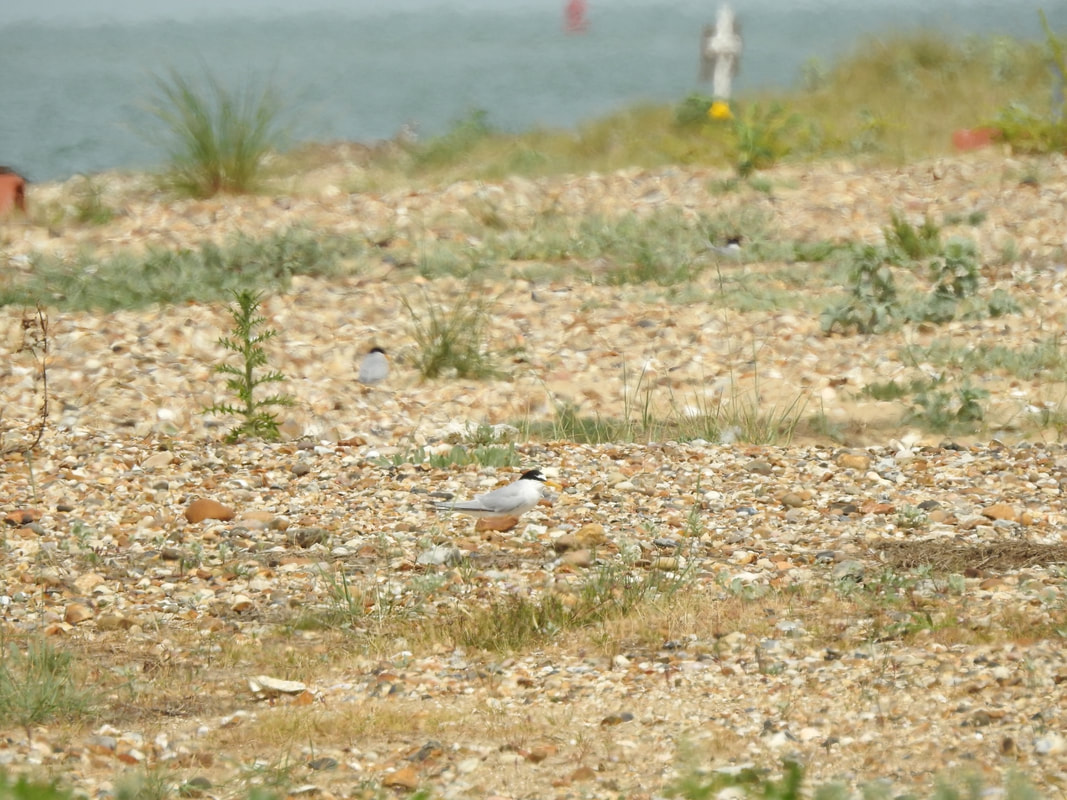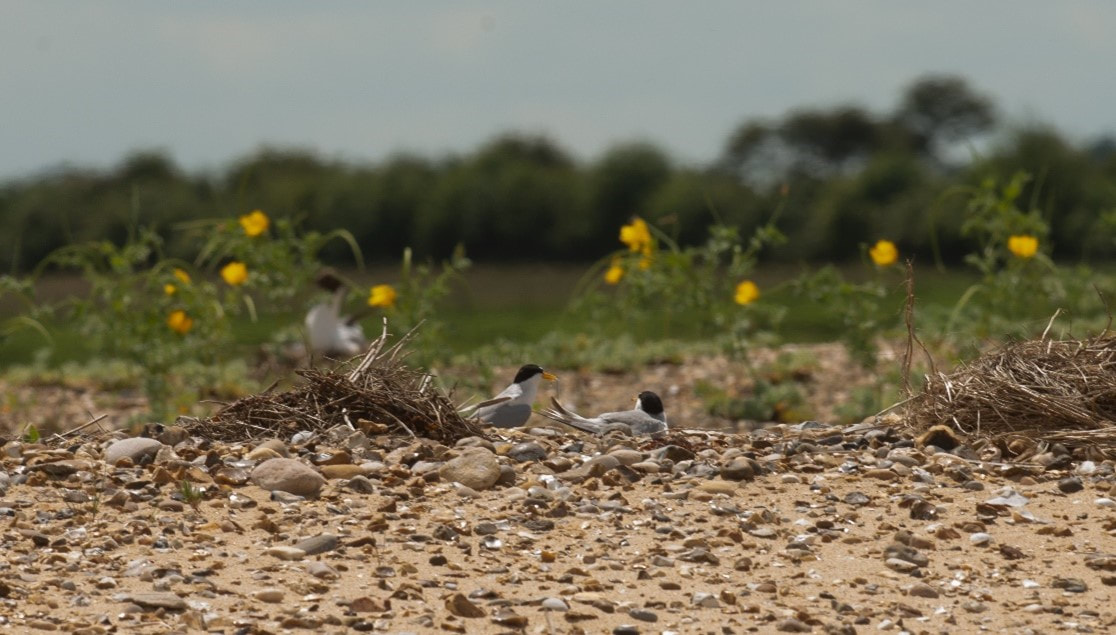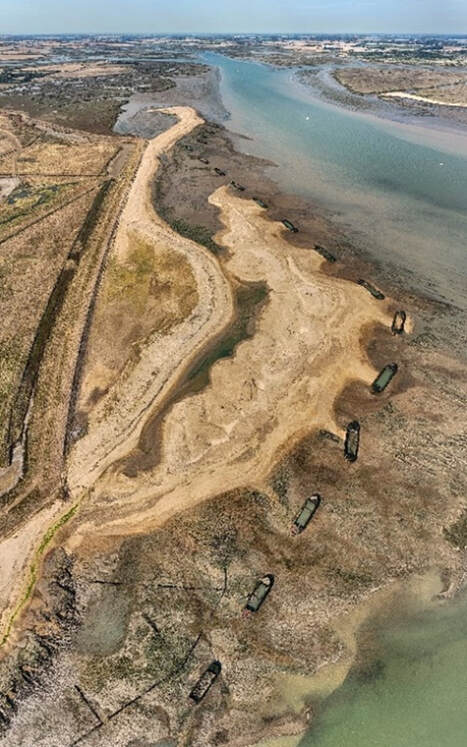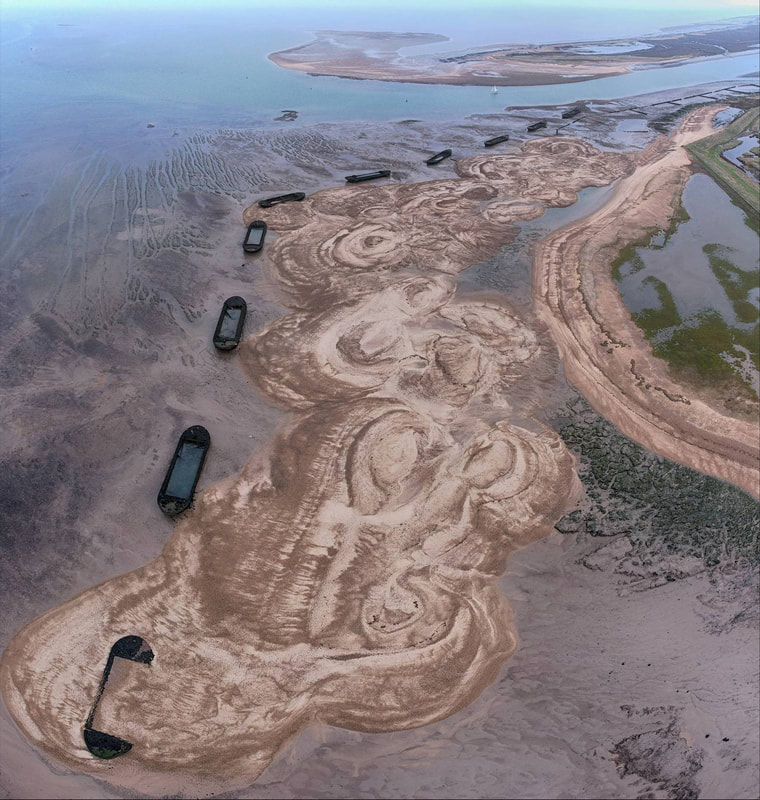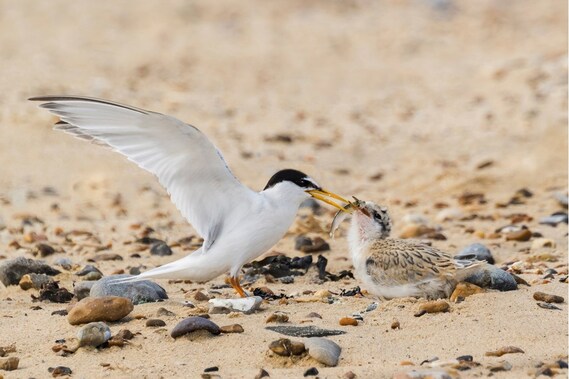|
Blog by Kieren Alexander, RSPB Site Manager for Old Hall Marshes It was a fantastic year on the newly created beach at Horsey Island. For those not familiar with this project, this was the creation of a new beach for little terns and other beach nesting birds to breed on, using 50,000 cubic metres of sand and shingle from the major channel deepening project carried out by Harwich Haven Authority. Along with providing breeding habitat for little terns and other beach nesting birds, the aim of the recharge scheme was also to help reduce erosion of the saltmarsh at Hamford water. This protected habitat, is vital for carbon storage, aiding in the fight against climate change. The project also assists in providing a natural wave break for the wider Hamford Water area, absorbing the energy before the waves reach the mainland and reducing pressure on the surrounding seawalls. Nesting on beaches, Little Terns are highly vulnerable to disturbance and erosion exacerbated by rising sea-levels throughout their breeding grounds. The project at Horsey Island, raises the height of a shingle beach out of the reach of the highest tides and hopefully secures this nesting location for the next 60 years. Below is a little video on how we created this new beach: Now in its 3rd year and approaching its 3rd breeding season, it is time report back on the results from 2023’s breeding season; in total 28 pairs of Little Terns successfully raised 42 chicks during this year’s breeding season at Horsey Island in Essex. Figures indicate that this year has seen the highest number of chicks taking to the skies since 2006. The site has also provided valuable habitat for other species including a Common Gull which fledged one chick this year from Horsey and is a rare occurrence in Essex and is possibly the first to have bred in Essex. This is an incredible result and a real success for all the organisations involved in the management of the beach from Tendring District Council, who warden the site and the wider Hamford water embayment, the landowners and HHA and the Environment Agency who helped fund the work. What has also been fascinating is watching the sand and shingle evolve over the three years, this winter has been a fascinating one for the beach, with a lot of strong north easterlies, the front edge of the beach has taken a lot of energy from the wave action and the higher-than-expected tides. Fascinatingly, in response to this and to maintain its stability beach and to absorb this energy, the beach has lowered and rolled back even further. Now that (hopefully) the strong storms are over, the relatively gentle wave energy should begin to pick up the height of the beach again as the crest of the beach will remain out of the water and shingle and sand will be picked up and forced up the beach. We will continue to monitor the beach both ecologically and geo-morphologically, with one final drone survey this Spring before we move to an annual monitoring drone flight to see how it is evolving over time and continued annual monitoring of the little tern population led by Tendring District Council and with the assistance of the landowners. In case you missed it, here is the link to first part of Horsey Island Recharge Project blog, the second part, the third part and the fourth part. Video credits: Jim Pullen/RSPB
0 Comments
Blog by Kieren Alexander, Site Manager for RSPB Old Hall Marshes After the successful recharge operation of Autumn/Winter 2021, attention has now turned to monitoring both the breeding colony present on the island and of course how the sand and shingle is moving and responding to the water. Thankfully its good news on both fronts! Starting with the little tern colony and other beach nesting bird that nest at Horsey. Little terns had a great year, with 22 nests fledging 19 young. There were 14 AON’s on the new recharge and a further 8 on the old recharge, this is an increase of 5 nests and 11 fledged juveniles from 2021 and a welcome return to form for this colony that decreased during 2020 and the impact of recreational disturbance. Ringed plovers did well, with all four pairs of young fledging at least one chick each. Oystercatchers stayed stable at 10 pairs and there were the normal low levels of black headed gulls. We are thankful to the environmental team at Tendring District council, in particularly Leon Woodrow for erecting signage and closely monitoring the species and any potential disturbance over the summer months. What has been impressive is the way the little terns immediately colonised the new area of beach, with many nests found on this new area, this shows the importance not just of safeguarding existing colonies from the impacts of climate change (which was one of the aims of the project) but also the vital need to create new habitats for our species. As well as the beach nesting colony we have also been monitoring the sand and shingle and how it is moving in response to tide and wind after being recharged. We are lucky at Horsey in that we have real life model that was created in the 1990’s in the form of the existing beach (to the west in the photo). So, we have a strong idea of how the material will respond. However, it is always nice to see the theory become reality. The GIF below shows the results of our monitoring since the material was deposited, so far, we have undertaken three monitoring flights and it shows the material initially being smoothed out and then gradually being pushed landwards towards the existing beach and then following a classic longshore drift movement to the west, making it a near mirror image of the existing beach.
Movement has been slow so far, but it is assumed that the material does a lot of its moving in the winter season, so the next results of the next two flights will be interesting to see and how it continues to respond. In case you missed it, here is the link to first part of Horsey Island Recharge Project blog, the second part and the third part. The works at Horsey have recently completed with a little under 50,000m3 of sand and shingle deposited on the foreshore. This was our first visit to look at the work at low tide and it the change is quite remarkable. An entirely new beach has been created. This drone photo taken from a recent survey shows what has been achieved in the month-long campaign. The material deposited will be fantastic for little terns and other beach nesting birds and looks on first inspection to be the perfect material with a fantastic mix of sand, shingles, and gravels. Remarkably the material is already moving inwards and will slowly wrap itself around the existing beach, hopefully in time for the next breeding season. When this process is complete it will look virtually indistinguishable from the existing beach but higher and more resilient.
We will continue to monitor the movement of the material with regular drone flights. We hope to write this scheme up as a case study and encourage future schemes by taking a strategic approach to BuDS throughout Kent and Essex. The Sospan Dau and its crew have now moved on the Blackwater estuary where they are carrying out similar works to those at Horsey. If you want to learn more about this works, the Mersea Harbour protection society have a great website here: https://savemerseaharbour.org/. This work will also stop coastal erosion and create new habitat for little terns within the estuary. All in all, over these two campaigns 150,000 m3 of sand and shingle will be deposited and there will be lots of exciting new habitat in place for next spring. In case you missed it, here is the link to first part of Horsey Island Recharge Project blog and the second part. Blog by Kieren Alexander, Site Manager for RSPB Old Hall Marshes Work is progressing nicely on the beneficial reuse project at Horsey island, with almost 25% of the material delivered by the Sospan Dau so far. The Sospan Dau is being skippered by a joint venture of Van Oord and Boskalis Westminster who have undertaken many such projects around the globe and are experts in this type of operation. They are able to access the disposal location at every high tide once they have found enough of the correct material from the Harwich Haven authority channel deepening source site, in this case sand and shingle. The material is then pumped ashore using a short length of floating pipe held in place by ropes and a small tugboat. This allows accurate disposal of the material and into the area it should be placed. You can track the boat here: Or here, MarineTraffic: Global Ship Tracking Intelligence | AIS Marine Traffic However, the best view is from the air and we were able to access Horsey last week and take this Drone footage. This shows the Sospan Dau approaching the island and discharging the material. At the moment the material resembles a large flat sand and shingle pancake. It will be shaped and sculpted by tide and wind over winter, moving landwards and westwards and in time building up the existing beach.
Although it doesn’t look like it now, the existing beach at Horsey is manmade, it was created in the 1990’s by the original Sospan Dau after a similar scheme where material was transported from a deepening project carried out by Harwich Haven Authority and the Environment Agency. It was after this that little terns colonised the beach and made this an important colony. However, the same forces that created the beach are also slowly causing it to be less suitable for nesting birds, it is slowly flattening out and lowering. This makes it much more vulnerable to storm events and high tides over the breeding season, which can lead to the complete loss of a breeding season. This work will make this scenario much less likely in the future in this location. In case you missed it, here is the link to first part of Horsey Island Recharge Project blog. Blog by Kieren Alexander, Site Manager for RSPB Old Hall Marshes Work will shortly commence on an exciting project at Horsey Island in Essex to secure and enhance the most important little tern colony in Essex. Using sand and shingle materials from the major channel deepening conducted by Harwich Haven. Funded by the EU Life+ project and the Environment Agency and with a major contribution from Harwich Haven Authority. This project aims to secure the future of the most important little tern colony in Essex, ensuring that it is secure from climate change and sea level rise for the next 50 years. Horsey Island is a private island in the north of Essex, it was first recharged in the 1990’s using sand and shingle from a previous deepening operation conducted by Harwich Haven Authority. More recently it has evolved into the most important little tern colony in Essex, ably wardened by the Ranger employed by Tendring District Council. Its unique offshore location means that it is relatively free of disturbance from people and mammalian predators this has allowed little terns to thrive and develop a productive colony. However, over time the beach has moved westward and landwards and gradually flattened out. This has meant the beach is increasingly vulnerable to high tide events especially over the breeding season. This means that to ensure that we can continue to provide habitat for little terns we need to recharge the recharge. Drone footage of the beach at Horsey Island, taken before the recharge operation. Credit: RSPB & Jim Pullen This is done by dredging sand and shingle then transporting it to the island, it is then deposited either via blowing it out over the bow or connecting a pipe and pumping it directly on to the foreshore. This is then moved around by the wind and tides until it settles on the existing beach raising the beach. This type of scheme is also known as a beneficial reuse scheme.
Not only will this project secure the future of the little tern colony, but it will also help to reduce erosion of saltmarsh, also a valuable and protected habitat. It will also maintain Horsey’s role as a wave break in the embayment, absorbing wave energy and helping to maintain the socio and economic and recreational opportunities this wonderful part of the Essex coast supports. The work is due to commence on or around the 30th of September and will last approximately a month. We will be updating the blog during the operation to track progress. |
Archives
April 2024
Categories
All
Photo credits: Oystercatcher by Katie Nethercoat (rspb-images.com)
LOTE Logo credits: Saskia Wischnewski |

